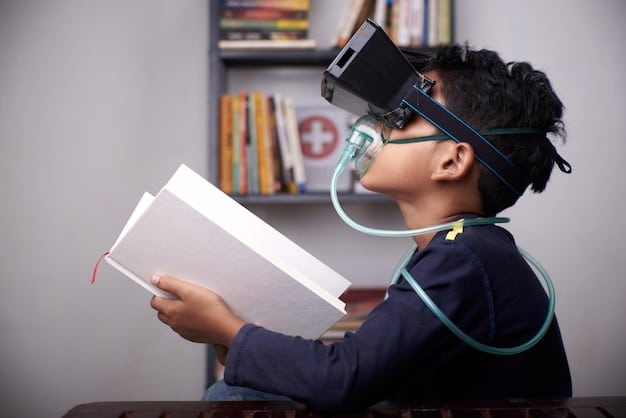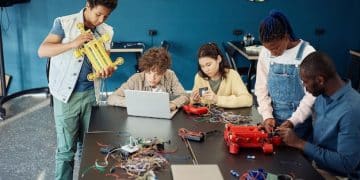The Latest on Learning Disabilities: Diagnostic Tools & Interventions

The latest research on learning disabilities focuses on advancing diagnostic tools and intervention strategies, seeking to provide more effective support for individuals with learning differences through tailored educational approaches.
Dive into the cutting-edge world of learning disability research, where the latest research on learning disabilities: new diagnostic tools and intervention strategies are revolutionizing how we understand and support those with learning differences. Stay informed about the newest approaches and insights in this critical field.
Unveiling New Diagnostic Approaches
Accurate and timely diagnosis is crucial for individuals with learning disabilities. The field is constantly evolving, with researchers exploring innovative methods to identify these challenges earlier and more effectively. These new approaches aim to provide a clearer understanding of each individual’s specific needs, paving the way for targeted interventions.
Advanced Cognitive Assessments
Traditional diagnostic methods often rely on standardized tests, but recent research emphasizes the importance of more nuanced assessments. Advanced cognitive assessments, incorporating measures of executive function, working memory, and processing speed, are gaining traction. These assessments provide a more comprehensive profile of an individual’s cognitive strengths and weaknesses.
Neuroimaging Techniques
Neuroimaging techniques such as fMRI (functional magnetic resonance imaging) and EEG (electroencephalography) are increasingly being used to investigate the neural underpinnings of learning disabilities. These technologies can help identify differences in brain structure and function that may contribute to learning difficulties, providing valuable insights for diagnosis and intervention.
- fMRI can reveal areas of the brain that are activated during specific learning tasks.
- EEG measures brainwave activity, which can be indicative of neurological dysfunction.
- These techniques offer a non-invasive way to study brain function in individuals with learning disabilities.
By incorporating these advanced diagnostic tools, educators and clinicians can gain a more accurate and comprehensive understanding of learning disabilities, enabling them to develop more effective and personalized intervention strategies.

Innovative Intervention Strategies
Once a learning disability has been diagnosed, effective intervention strategies are essential to support the individual’s academic and personal growth. Recent research has led to the development of innovative interventions that address the specific needs of learners with different types of learning disabilities. These strategies aim to enhance cognitive skills, improve academic performance, and promote self-esteem.
Personalized Learning Programs
Personalized learning programs are becoming increasingly popular in the field of learning disabilities. These programs are designed to tailor instruction to the individual’s specific learning style, strengths, and weaknesses. By providing customized support and targeted interventions, personalized learning programs can help learners with disabilities achieve their full potential.
Assistive Technology
Assistive technology plays a crucial role in supporting learners with learning disabilities. From text-to-speech software to graphic organizers and digital note-taking tools, assistive technology can help individuals overcome learning barriers and access information more effectively. Recent advances in assistive technology have made these tools more accessible and user-friendly.
- Text-to-speech software can help students with reading difficulties decode text.
- Graphic organizers can help students with organizational challenges structure their thoughts and ideas.
- Digital note-taking tools can help students with attention deficits stay focused and engaged in class.
Innovative intervention strategies, such as personalized learning programs and assistive technology, are transforming the way we support learners with learning disabilities, enabling them to succeed academically and thrive personally.
The Role of Early Intervention
Early intervention is paramount in addressing learning disabilities. Research consistently shows that the earlier interventions are implemented, the better the outcomes for individuals with learning disabilities. Early identification and intervention can prevent academic failure, reduce social-emotional difficulties, and improve long-term prospects.
Screening and Identification
Effective early intervention begins with screening and identification. Schools and healthcare providers should implement routine screening procedures to identify children at risk for learning disabilities. Early screening can help detect potential problems before they escalate, allowing for timely intervention.
Evidence-Based Interventions
Once a learning disability has been identified, evidence-based interventions should be implemented as soon as possible. Evidence-based interventions are those that have been shown to be effective through rigorous research. These interventions may include specialized tutoring, individualized instruction, and behavioral interventions.
Implementing comprehensive early intervention programs can significantly improve the trajectory for children with learning disabilities, setting them on a path toward academic success and lifelong learning.
Impact of Socio-Emotional Factors
Learning disabilities can have a profound impact on an individual’s socio-emotional well-being. Children and adults with learning disabilities may experience feelings of frustration, anxiety, and low self-esteem. These socio-emotional challenges can further exacerbate academic difficulties and hinder overall development. Addressing these factors is critical in supporting the holistic development of individuals with learning disabilities.
Building Self-Esteem
Helping individuals with learning disabilities build self-esteem is essential. This can be achieved by focusing on their strengths, providing opportunities for success, and fostering a positive and supportive learning environment. Educators and parents can play a crucial role in building self-esteem by praising effort and progress, rather than focusing solely on academic achievement.

Promoting Social Skills
Individuals with learning disabilities may also struggle with social skills. Providing opportunities to practice social skills, such as communication, cooperation, and conflict resolution, can help them build positive relationships and navigate social situations more effectively. Social skills training can be integrated into the classroom curriculum or provided in small-group settings.
- Role-playing activities can help individuals practice social interactions in a safe and supportive environment.
- Group projects can provide opportunities for collaboration and teamwork.
- Direct instruction in social skills can equip individuals with the knowledge and strategies they need to succeed in social situations.
By addressing the socio-emotional needs of individuals with learning disabilities, educators and parents can help them develop the resilience, self-confidence, and social skills they need to thrive in all aspects of life.
Technology-Driven Solutions
Technology is revolutionizing the field of learning disabilities. From diagnostic tools to intervention strategies, technology offers a wide range of solutions to support learners with disabilities. These technology-driven solutions can enhance engagement, personalize instruction, and improve outcomes.
Educational Apps and Software
A plethora of educational apps and software programs are available to support learners with learning disabilities. These tools can help with reading, writing, math, and other academic skills. Many of these apps and programs are designed to be engaging and interactive, making learning more fun and effective.
Virtual Reality (VR) and Augmented Reality (AR)
Virtual reality (VR) and augmented reality (AR) technologies are emerging as promising tools for supporting learners with learning disabilities. VR and AR can create immersive and interactive learning experiences that can help individuals develop specific skills and knowledge. For example, VR can be used to simulate real-world situations, such as social interactions or workplace tasks, allowing individuals to practice these skills in a safe and controlled environment.
- AR apps can overlay digital information onto the real world, providing learners with visual aids and prompts.
- VR simulations can create engaging learning experiences that can help individuals develop specific skills.
- These technologies offer new and exciting ways to support learners with learning disabilities.
Technology-driven solutions are transforming the way we support learners with learning disabilities, providing them with access to personalized, engaging, and effective learning experiences.
Collaborative Approaches in Education
Effective support for individuals with learning disabilities requires a collaborative approach involving educators, parents, healthcare providers, and other professionals. When these stakeholders work together, they can create a comprehensive and coordinated support system that addresses the individual’s unique needs.
Parent Involvement
Parent involvement is crucial to the success of learners with learning disabilities. Parents can provide valuable insights into their child’s strengths, weaknesses, and learning style. They can also reinforce learning at home and advocate for their child’s needs in school.
Interdisciplinary Teams
Interdisciplinary teams, consisting of educators, psychologists, speech-language pathologists, and other professionals, can provide comprehensive assessments and develop individualized education programs (IEPs) that address the individual’s specific needs. These teams can also monitor progress and adjust interventions as needed.
By fostering collaboration among all stakeholders, we can create a supportive and inclusive environment that empowers individuals with learning disabilities to achieve their full potential.
| Key Point | Brief Description |
|---|---|
| 🔍 Diagnostic Tools | Advanced assessments and neuroimaging techniques for early and accurate identification. |
| 💡 Intervention Strategies | Personalized learning, assistive technology, and evidence-based programs. |
| 🌱 Early Intervention | Routine screening and timely, evidence-based interventions for better outcomes. |
| 🤝 Collaborative Approaches | Involving educators, parents and healthcare providers for coordinated support. |
Frequently Asked Questions
▼
The latest tools include advanced cognitive assessments that measure executive function and neuroimaging techniques like fMRI and EEG, providing detailed brain function insights.
▼
They tailor instruction to individual learning styles, strengths, and weaknesses, offering customized support and targeted interventions for better academic outcomes.
▼
Assistive technology like text-to-speech software and graphic organizers helps overcome learning barriers, providing easier access to information and improved learning experiences.
▼
Early intervention can prevent academic failure, reduce socio-emotional difficulties, and improve long-term prospects by addressing issues before they escalate.
▼
Collaborative approaches involving educators, parents, and healthcare providers ensure a coordinated support system, addressing each learner’s unique needs comprehensively.
Conclusion
The landscape of learning disability research is continuously evolving, offering new hope and possibilities for those affected. By embracing innovative diagnostic tools, implementing targeted intervention strategies, and fostering collaborative partnerships, we can create a more inclusive and supportive educational environment where every individual has the opportunity to thrive.





